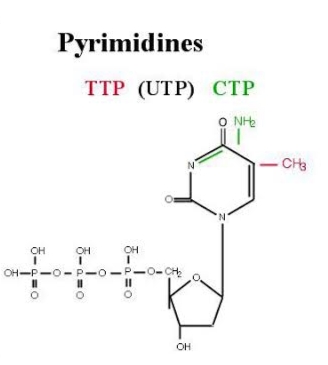Purines and Pyrimidines are two types of nitrogenous bases found as the building blocks of nucleic acid of both DNA and RNA. Equal amounts of purines and Pyrimidines are found in cells. Both purines and Pyrimidines are heterocyclic, aromatic organic compounds which are involved in the synthesis of proteins and starch, regulation of enzymes and cell signaling. Two types of purines and three types of Pyrimidines are found in the nucleic acid structure. Adenine and guanine are the two purines and cytosine, thymine and uracil are the three Pyrimidines.
What Are Purines?
Purine is any class of organic compounds of the heterocyclic series characterized by two-ringed structure composed of carbon and nitrogen atoms. Heterocyclic compounds are organic compounds (containing carbon) that contain a ring structure containing atoms in addition to carbon, such as sulfur, oxygen or nitrogen as part of the ring. Purines are the most widely occurring nitrogen-containing heterocycles in nature.
Purines are found in high concentration in meat and meat products, especially internal organs such as liver and kidney. A plant-based diet is generally low in Purines, although there are significantly amounts in dry beans, spinach and mushrooms.

There are many naturally occurring purines. They include adenine and guanine, which participate in DNA and RNA formation. In DNA, these bases form hydrogen bonds with their complementary Pyramidines, thymine and cytosine, respectively. This is called complementary base pairing. In RNA, the complement of adenine is uracil instead of thymine. Purines are also constituents of other important biomolecules such as ATP, GTP, cyclic AMP, NADH and coenzyme A.
Other notable purines are:
- Hypoxanthine
- Xanthine
- Theobromine
- Caffeine
- Uric acid
- Isoguanine
Facts About Purines
- Purine is a heterocyclic aromatic organic compound organic compound composed of a pyramid ring fused with imidazole ring.
- The chemical formula of purine is- C5H4N4.
- It comprises adenine and guanine as nucleobases.
- Purines are bigger in size.
- It consists of two hydrogen-carbon rings and four nitrogen atoms.
- The melting point of purine is 214oC (417oF, 487 K).
- The boiling point of purine is 424oC.
- Catabolism results in the production of uric acid.
- The molar mass of purine is 120.115 g/mol.
- Biosynthesis takes place in the liver.
- Purines are soluble in water.
What Are Pyrimidines?
Pyrimidine can be described as any of a class of organic compounds of the hetrocyclic series characterized by a ring structure composed of four carbon atoms and two nitrogen atoms. The term pyrimidine is also used to refer to pyrimidine derivatives, most notably the three nitrogenous bases that, along with the two purines, are the building blocks of both deoxyribonucleic acid (DNA) and ribonucleic acid (RNA). The pyrimidine nitrogenous bases are derived from the organic compound pyrimidine through the addition of various function groups. In nucleic acids, Cytosine (C), Thymine (T) and Uracil (U) are the three types of nucleobases pyramidine derivatives.

Thymines and cytosines are usually present in DNA while uracil and cytosine are found in RNA. Uracil, thymine and cytosine are ubiquitously present in nucleic acids in the form of the corresponding nucleosides in significant amounts (each accounting for at least 5% of the total bases in nucleic acids).
Facts About Pyrimidines
- Pyrimidine can be described as any of a class of organic compounds of the hetrocyclic series characterized by a ring structure composed of four carbon atoms and two nitrogen atoms.
- The chemical formula of Pyrimidines is C5H4N4.
- It comprises Cytosine in both DNA and RNA, Uracil only in RNA and Thymine only in DNA.
- Pyrimidines are relatively smaller in size.
- It consists of one hydrogen-carbon ring and two nitrogen atoms.
- The melting point of Pyrimidines is 20-22oC (68-72oF, 298 to 295K).
- Pyrimidine has a boiling point of 123 to 124oC.
- Catabolism produces carbon dioxide, beta-amino acids and ammonia.
- The molar mass of Pyrimidines is 80.088 g/mol.
- Biosynthesis takes place in different tissues.
- Pyrimidines are insoluble in water.
Also Read: Difference Between Nucleotide And Nucleoside
Difference Between Purines And Pyrimidines In Tabular Form
| BASIS OF COMPARISON | PURINES | PYRIMIDINES |
| Formula | C5H4N4 | C4H4N2 |
| Classification | Heterocyclic compound | Heterocyclic compound |
| Molar Mass | 120.115 g/mol | 80.088g/mol |
| Melting Point | 214oC (417oF, 487 K) | 20-22oC (68-72oF, 298 to 295K) |
| Density | 1.5g/cm3 | 1.016g/cm3 |
| Boiling Point | 424oC (697.2K, 795.3oF) | 123 to 124oC (253 to 255oF, 396 to 397K). |
| Solubility In Water | Soluble/ Miscible 500 g/L at (25oC). | Miscible/Insoluble (at 25oC). |
| Size | Purines are bigger in size. | Pyrimidines are relatively smaller in size. |
| Nucleobases | It comprises adenine and guanine as nucleobases. | It comprises Cytosine in both DNA and RNA, Uracil only in RNA and Thymine only in DNA. |
| Number of Hydrogen-Carbon Rings | It consists of two hydrogen-carbon rings and four nitrogen atoms. | It consists of one hydrogen-carbon ring and two nitrogen atoms. |
| Catabolism | Catabolism results in the production of uric acid. | Catabolism produces carbon dioxide, beta-amino acids and ammonia. |
| Biosynthesis | Biosynthesis takes place in the liver. | Biosynthesis takes place in different tissues. |
| Solubility | Purines are soluble in water. | Pyrimidines are insoluble in water. |